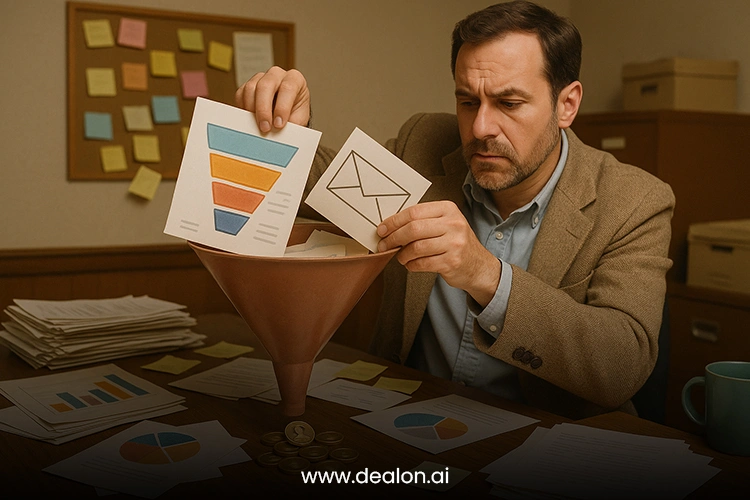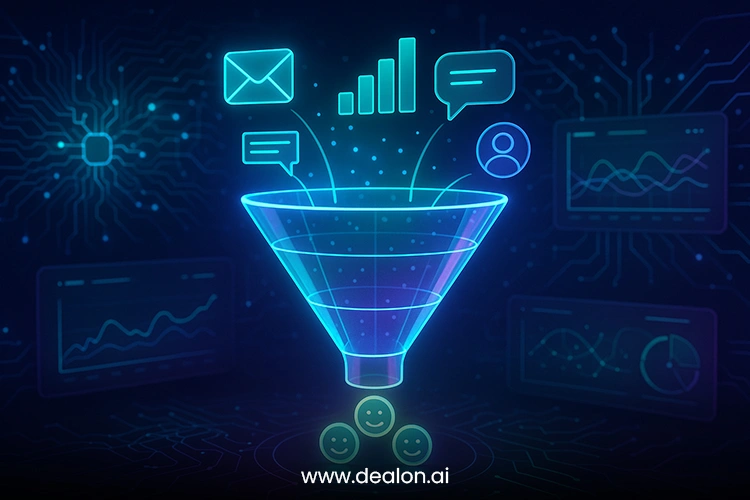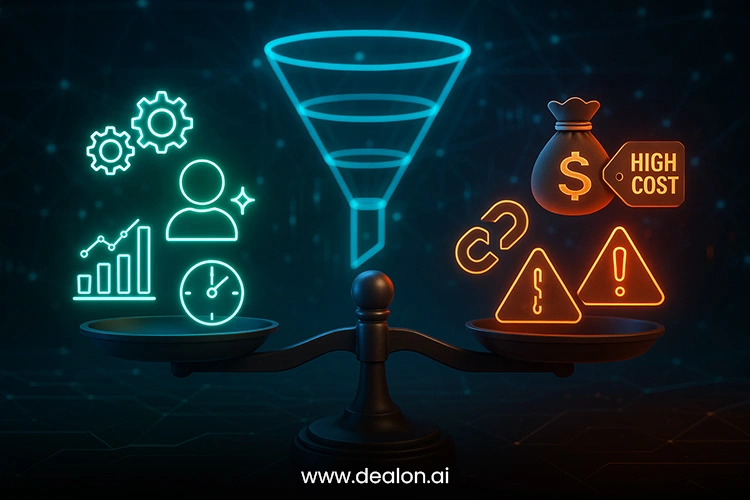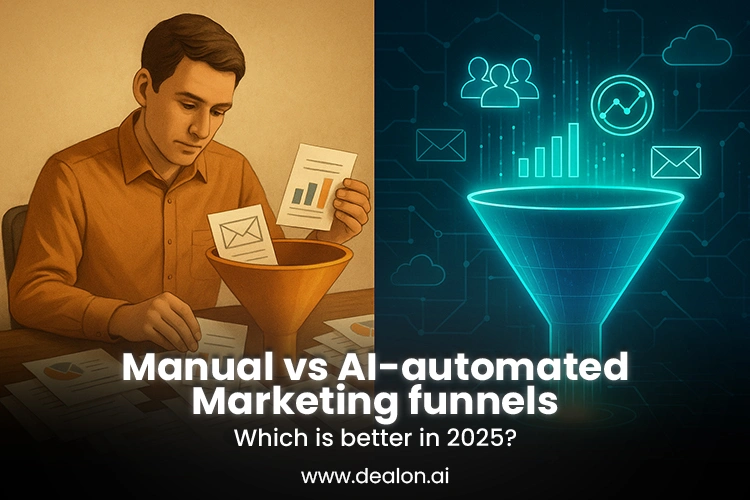In the wake of 2025, the area of digital marketing is shifting toward a very drastic change, driven by the constantly expanding capacity of artificial intelligence (AI). The power and accuracy of AI-driven funnels are further pushing out traditional manual marketing funnels, which were the benchmark in driving leads towards conversion. Whereas manual approaches require extensive human contribution and guesswork, funnels powered by AI will help make every step of the customer journey more optimal by using data analytics, machine learning, and automation.
The ultimate benefits of funnel-based AI cannot be justifiable in a place where customization, velocity, and expansion are essential client lines of action, equivalent to advantages to a corporate body. Dynamic adjustments of the content, messaging, and timing according to individual contact guarantee a better targeted and more efficient process of lead nurturing. Moreover, being able to process large quantities of data, AI allows predictive judgments to be made, so the requirements of the customers and their behavior can be predicted with high precision.
But, what is more of a question here is the benefits of the use of AI in marketing, indeed, when it comes to funnels? So are manual funnels good enough in 2025, or are AI-driven systems more apt at generating good and sustainable customer relationships? In a future blog post, the present author will discuss the significant distinctions between the manual marketing funnels and AI-based alternatives, and how they both fit into the changing marketing environment, and which one is the most efficient when it comes to businesses hoping to prosper in the upcoming decades.
Regardless of whether you want to streamline your existing marketing approach or switch to AI-based systems, it is essential to learn more about these two methods to survive in the new marketing environment in 2025.
Also Read: Digital Therapist in Mental Health: Chatbots and AI In 2025
Manual Marketing Funnels: What are they?

Manual marketing funnels, which are the standard or traditional most commonly used tactic in making prospects go through the sales process, were central to digital marketing tactics over the past 30 years. The steps or phases of these funnels mainly include awareness, interest, consideration, and conversion, where the marketers at the end tend to make use of content, email sequences, landing pages, and advertisements to convey the leads on these progressions systematically. The work involves a significant amount of practical management, including dividing recipients into different lists, customizing messages, and measuring success using analytics.
The key ability that the marketer can do at the center of a manual funnel is segmenting leads and being able to predict what type of content will be appealing to each of the groups. Marketers are using historical and customer behaviour data to manually set up targets with campaigns that can be expensive and time-consuming.
This is usually a trial-and-error method whereby the campaigns and follow-up strategies are tweaked depending on the response rates and tracking of performance. Manual funnels may work, but very soon they end up being ineffective when scaling up the campaigns due to the involved complexities of consumer behavior. Marketers constantly have to evaluate and update their strategies, which may cause ineffectiveness when handling more leads.
With expanding businesses and the ever-increasingly digital and data-driven interactions with customers, the manual marketing funnels are strained. It becomes more challenging to meet the high-paced levels of marketing that are multi-channel demanding due to the need for human intervention and constant changes. Although not losing its relevance in some aspects, manual funnels are increasingly awkward and incapable of handling the new sophistication of contemporary marketing.
What are AI-enhanced Marketing Funnels?

AI marketing funnels take classic lead generation and nurturing techniques to the next level, offering a dose of automation and smarts that manual funnels can never achieve. These funnels are backed by enhanced machine learning algorithms, predictive analytics, and behavioral data, which help automatically nurture leads through the entire sales process, taking them through the phases of awareness, engagement, consideration, and conversion. There is much more that can be automated with the help of AI tools: segmentation of leads, personalized emails, recommended content, and scoring leads based on real-time behavior.
A significant strength associated with AI-powered funnels is the capacity to keep on changing and learning during the engagement with leads. When a prospect interacts with material, artificial intelligences monitor their actions and adjusts approaches to make their experiences more tailored. As an example, the AI can be used to change the timing of the emails, suggest particular products or services, and alter the message according to the previous actions of the lead. This flexibility allows the funnel to be current, and more chances will emerge to achieve conversion since each lead is cultivated in a manner that is related to their needs.
Moreover, AI-driven funnels can predict a lead conversion likelihood through the application of predictive analytics and thereby enable businesses to direct resources towards those leads that are most likely to turn into customers. With each iteration of refining its view of customer behavior, AI gets better and better at predicting the results and achieving them with better efficiency. In 2025, AI-powered funnels have become an imperative tool in modern marketing because of saving valuable time, nurturing leads, and achieving improved outcomes via automation of the most useful processes and the personalization of the experience.
Pros and Cons of AI-driven Marketing Funnels

Pros
- Automation at Scale: Automation is most likely one of the most publicized advantages of AI-based funnels, which is the ease of repetitive tasks. Automation helps with activities like lead scoring, segmentation, and content personalization, which can free up marketing teams to spend time doing more strategic work that is more creative and needs more skills. This automation reduces the amount of time, increases accuracy, and unblocks funds and resources for other high-value tasks. Thus, an AI funnel is a must-have tool when a company intends to scale.
- Personalization: AI funnels bring personalization up a notch by automatically adapting content, timing, and recommendations based on individual lead behaviour. As opposed to a one-size-fits-all approach, AI systems monitor interactions with customers in real-time and adjust the experience. It leads to an extremely contextualized experience with the lead, and it enhances interaction and the probability of conversion. By offering individualized experiences in multiple touchpoints, companies will be able to make a stronger connection with their audience.
- Forecast Likelihood Of Conversion: AI-based funnels do a great job when it comes to offering predictive insights to determine the likelihood of a lead converting using massive data sets. Through monitoring trends of customer actions and prior data, AI will be able to forecast how likely leads are to navigate through the funnel and eventually become paying consumers. This can assist businesses to concentrate on high-value leads, divide resources better, and concentrate on leads to drive revenues.
- Better Efficiency: Since AI learns and improves with every interaction it makes with its leads, it will be more efficient in optimising the campaigns. Its algorithms are continuously honed, and the system works more precisely and performs better as it is used. Being able to make data-driven decisions means that businesses will be able to streamline their business strategies and experience a greater rate of conversion and less wasted effort.
- Real-Time Adjustments: There is a massive benefit that AI-generated funnels can be adjusted in real-time. The system is also capable of dynamically updating its strategies, shifting content, timing, or the outreach channels based on the behavior of the leads in case they begin to interact with the content or take some actions in different touchpoints. Such responsiveness implies that even as customer behavior and preferences change, the marketing plan would continue to be effective and up to date.
- Customization: Among the many outstanding benefits of manual marketing funnels lies the extent of control one is able to exercise with them. Marketers can personalize every part of the funnel, including the creation of content and follow-up emails to the last detail. This provides an outstanding possibility to conduct very personal campaigns which directly appeal to the needs and expectations of a target audience. The ability to change messaging, timing, and channel is a competitive advantage to marketers in their quest to reach that level of personalization that leads to stronger relationships with their potential customers.
- Easy to install: Installing manual funnels is relatively simple when compared to those that require more advanced skills for beginners in digital marketing. There are reduced technicalities that make it easier to implement a basic funnel strategy quickly among businesses with limited resources. Manual funnels offer smaller enterprises an easy way into the world of funnels because tools like landing pages, email sequences, and simple lead magnets do not require complex technologies or large marketing budgets.
- Human Touch: Manual marketing funnels would usually have an advantage along the lines of having human intuition and creativity. It is possible to design a campaign that significantly communicates with the audience because of the experience and the industry knowledge available to the marketers. This human touch makes the communications appear personal and is likely to promote more genuine customer interest. Manual funnels also offer a chance of an individual encounter for businesses that emphasize one-to-one contact with the audience.
Cons:
- Lateral Initial Expense: It usually takes more money to implement AI-powered marketing funnels than the manually executed systems, especially in terms of tools, technology, and training. Although AI systems are more scalable and efficient in the long term, the initial investment and implementation may be costly, and thus not a feasible idea for smaller companies or those companies that have low budgets.
- Dependence on Data: AI-driven funnels are highly dependent on data, and high-quality data is essential to work well. Inaccurate, incomplete, and poorly structured data entered into the system may diminish the predictive capabilities of the AI and, as a result, its performance. Businesses need to make sure that the processes of data collection are solid and ensure that they can access clean and reliable data so that their AI-powered funnels are successful.
- Labor-Intensive: This is one of the hefty disadvantages of the manual funnels: the amount of work they require and the time it takes. To handle the leads, generate unique content, and manually optimize campaigns on the basis of performance is an intensive resource. These tasks get exponentially harder to handle as businesses grow and their number of customers increases. In an environment that is not automated, the marketer is not far behind in being overwhelmed by the complexity of their campaigns.
- Problems with Scalability: Manual funnels tend to have issues when the company is growing and the demand needs to be met. This is because the bigger the number of prospects, the less likely they feel of being able to compartmentalize leads and generate personalized outreach. Manual manipulation of every lead is no longer feasible by marketers, creating the possible failure of potential leads and funnel bottlenecks. Scaling involves the introduction of additional human resources that are inefficient and expensive.
- Weak Predictive Abilities: Manual funnels are based more on records, gut feelings, and assumptions concerning how customers act. Although this can sometimes be very effective, in most cases, they do not have the level of sophistication to predict future behaviors correctly. To make decisions, marketers have to use broad trends or anecdotes, which would result in poor targeting and ineffective use of marketing campaigns.
Manual marketing funnels vs. AI-powered funnels: What will be better in 2025?
Heading towards the year 2025, digital marketing keeps pace at a hyperbolic rate. Businesses are exposed to a more complex environment where consumer expectations are becoming tougher, competition is on the rise, and there is a need to engage in a more personalized and efficient marketing process. To remain one step ahead of the competition, the companies will have to adopt marketing systems capable of manipulating large volumes of data, reacting to consumer behaviors in real-time, and optimizing campaign performance constantly. And the AI-enabled marketing funnels can excel in this case.
AI-driven funnels provide a certain scalability and flexibility that manual funnels cannot match. AI-powered funnels can automatically segment leads, personalize messages, and customize content delivery via large-scale lead segmentation by using machine learning, predictive analytics, and real-time data processing capabilities. This kind of automation does away with cumbersome duties and guarantees the ability of businesses to answer leads in a timely and correct manner, leading to greater chances of conversion. In addition, AI funnels can always learn and change the strategies depending on the user habits and make amends to the campaigns to provide results that will yield continuously better results.
However, now, the manual marketing funnels also have their value, especially in smaller companies or those companies that are only unfolding to digital marketing. The manual mode also permits a more creative, tactile process where marketers are fully able to control each aspect of the funnel. This control can provide an intimate, closer relationship with the prospects, particularly with the businesses that have few leads and scant material. Manual ones are less technical and can be implemented more easily most of the time, and are preferred by companies that believe in the importance of direct and human interaction.
Nevertheless, as marketing goes more data-focused and businesses aim to grow even bigger, AI funnels are set to clear the field. They are the most efficient and precise, which means that companies can work on their strategy, whereas automation does all the hard work. AI-driven funnels will become the most popular process when companies have the desire to maximize their lead-generating activities and attempt to remain competitive in a hectic world of digital areas.
Conclusion
Manual and AI-driven marketing funnels have individual benefits; however, current trends in digital marketing in 2025 will utilize AI-driven marketing funnels. The scalability, automation, and accuracy that AI-powered funnels offer to businesses are impossible to match with conventional funnels and allow companies working with large sets of data to present each client with a very personalized yet data-driven campaign.
Although manual funnels are perfectly appropriate in smaller businesses or when a company is just beginning, they do not have the flexibility and speed of artificial intelligence-powered funnels. With the growth of companies and the demands of consumers, AI funnels are becoming more and more inevitable, and the tools one can receive with the help of these mechanisms enable them to maximize their marketing efforts, improve their consumers’ experiences, and remain relevant in the fast-changing digital world.

